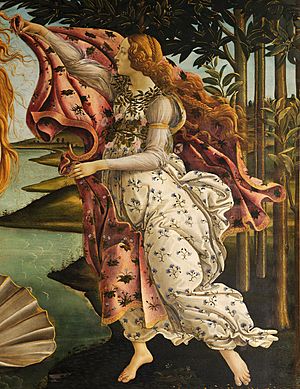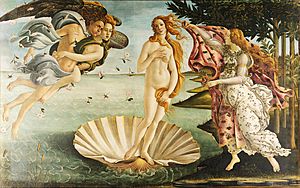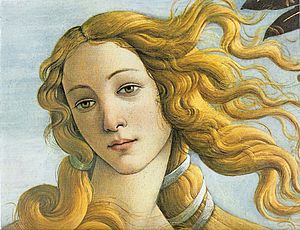The Birth of Venus (Botticelli) facts for kids
The Birth of Venus is a very famous painting by Sandro Botticelli (1445 – May 17, 1510). It shows the Roman goddess Venus. Botticelli painted her standing on a giant shell. This idea came from a poem by Angelo Poliziano, which said Venus was born from foam in the sea. The painting shows Zephyr, the god of winds, holding Aura, the gentle breeze. They are blowing Venus towards the shore. There, Horae, the goddess of the seasons, waits with a cloak for her. Venus is shown without clothes to represent her innocence and divine nature.
What the Painting Shows

In the middle of the painting, the goddess Venus has just been born. She stands on a huge scallop shell. This shell is much bigger than real ones, but it was often used in old stories and art about Venus.
On the left side, the wind god Zephyrus blows at Venus. You can see lines coming from his mouth, showing the wind. He is flying and carries a young woman. She is also blowing, but not as strongly. Both Zephyrus and the young woman have wings. This young woman is likely Aura, who represents a gentle breeze. Their combined efforts blow Venus towards the shore. Their strong winds also make the hair and clothes of the other figures on the right move.
On the right, a female figure seems to float slightly above the ground. She holds out a rich cloak or dress. This is to cover Venus when she reaches the shore. This figure is one of the three Horae or Hours. These were Greek goddesses of the seasons and other parts of time. They were also helpers of Venus. The flowers on her dress suggest she is the Hora of Spring. She stands in a relaxed and joyful pose, similar to Venus, happy that Venus has arrived.
Some people think the two other female figures might be different. The nymph held by Zephyrus could be Chloris, a flower nymph. And the figure on land might be Flora. Flora is usually the Roman version of the Greek Chloris. In another Botticelli painting, the Primavera, Chloris changes into Flora. However, it's hard to see that happening here. Still, the roses blowing with the two flying figures would fit the story of Chloris.
The painting's name, "The Birth of Venus," was given to it much later, in the 1800s. The painting actually shows the next part of her story: her arrival on land. She is blown there by the wind. This land probably represents either Cythera or Cyprus. These are Mediterranean islands that the Greeks believed were Venus's special places.
When and Where the Painting Was Made
People have long thought that the powerful Medici family in Florence asked Botticelli to paint this artwork. Perhaps Lorenzo di Pierfrancesco de' Medici (1463–1503), who supported Botticelli, ordered it. He might have been influenced by his cousin, Lorenzo de' Medici, known as "il Magnifico."
This idea was first suggested in 1908 and was believed for a long time. However, more recently, some experts have doubted it. Still, some interpretations of the painting's meaning depend on this idea. Even though the relationship between "il Magnifico" and his younger cousins, Lorenzo di Pierfrancesco and Giovanni di Pierfrancesco de' Medici, might have been difficult, it could have been a good idea to commission a painting that honored the older Lorenzo.
One expert, Herbert Horne, thought the painting was ordered soon after 1477. That year, Lorenzo and Giovanni bought the Villa di Castello, a country house outside Florence. They were rebuilding it. Their father had died the year before, leaving the young boys under the care of their cousin, Lorenzo il Magnifico.
There are no official records of who first asked for the painting. The first mention of it comes from Giorgio Vasari. He saw it, along with another painting called the Primavera, at Castello sometime before 1550. However, in 1975, it was discovered that "The Birth of Venus" was not listed in a detailed inventory of Lorenzo di Pierfrancesco's family art from 1499. This suggests the Medici family might have owned it later.
Horne thought the painting was made between 1477 and 1481. But many modern experts now believe it was painted around 1484–1486. This is based on how Botticelli's painting style developed. The Primavera is usually thought to be older, perhaps from around 1482.
Whenever these two paintings were brought together at Castello, they have stayed together ever since. They remained at Castello until 1815. Then, they were moved to the Uffizi Gallery. For some years until 1919, they were kept in the Galleria dell'Accademia, another government museum in Florence.
Painting Style
The way Venus is posed in the painting is similar to some ancient Greek and Roman sculptures. For example, her hand positions are like those of the Venus Pudica type, which means "modest Venus." However, the overall look of Venus, standing off-center with long, flowing lines, also shows many features from Gothic art.
See also
 In Spanish: El nacimiento de Venus (Botticelli) para niños
In Spanish: El nacimiento de Venus (Botticelli) para niños



